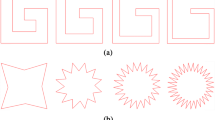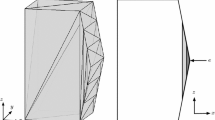Abstract
In this paper, we prove that the standard adaptive finite element method with a (modified) maximum marking strategy is instance optimal for the total error, being the square root of the squared energy error plus the squared oscillation. This result will be derived in the model setting of Poisson’s equation on a polygon, linear finite elements, and conforming triangulations created by newest vertex bisection.







Similar content being viewed by others
References
E. Bänsch, Local mesh refinement in 2 and 3 dimensions, IMPACT Comput. Sci. Engrg. 3 (1991), 181–191.
P. Binev, W. Dahmen, and R. DeVore, Adaptive finite element methods with convergence rates, Numer. Math. 97 (2004), no. 2, 219–268.
P. Binev, Adaptive methods and near-best tree approximation, Oberwolfach Reports, vol. 29, 2007, pp. 1669–1673.
I. Babuška and W. C. Rheinboldt, Error estimates for adaptive finite element computations, SIAM J. Numer. Anal. 15 (1978), no. 4, 736–754.
I. Babuška and M. Vogelius, Feedback and adaptive finite element solution of one-dimensional boundary value problems, Numer. Math. 44 (1984), no. 1, 75–102.
J. M. Cascón, C. Kreuzer, R. H. Nochetto, and K. G. Siebert, Quasi-optimal convergence rate for an adaptive finite element method, SIAM J. Numer. Anal. 46 (2008), no. 5, 2524–2550.
W. Dörfler, A convergent adaptive algorithm for Poisson’s equation, SIAM J. Numer. Anal. 33 (1996), 1106–1124.
I. Kossaczký, A recursive approach to local mesh refinement in two and three dimensions, J. Comput. Appl. Math. 55 (1994), 275–288.
J. M. Maubach, Local bisection refinement for n-simplicial grids generated by reflection, SIAM J. Sci. Comput. 16 (1995), 210–227.
P. Morin, R. H. Nochetto, and K. G. Siebert, Data oscillation and convergence of adaptive FEM, SIAM J. Numer. Anal. 38 (2000), 466–488.
P. Morin, R. H. Nochetto, and K. G. Siebert, Convergence of adaptive finite element methods, SIAM Review 44 (2002), 631–658.
P. Morin, K. G. Siebert, and A. Veeser, A basic convergence result for conforming adaptive finite elements, Math. Models Methods Appl. Sci. 18 (2008), no. 5, 707–737.
R. H. Nochetto, K. G. Siebert, and A. Veeser, Theory of adaptive finite element methods: An introduction, Multiscale, Nonlinear and Adaptive Approximation (Ronald A. DeVore and Angela Kunoth, eds.), Springer, 2009, pp. 409–542.
A. Schmidt and K. G. Siebert, Design of adaptive finite element software. The finite element toolbox ALBERTA, Lecture Notes in Computational Science and Engineering 42. Springer 2005 (English).
R.P. Stevenson, Optimality of a standard adaptive finite element method, Found. Comput. Math. 7 (2007), no. 2, 245–269.
R.P. Stevenson, The completion of locally refined simplicialpartitions created by bisection, Math. Comp. 77 (2008), no. 261, 227–241 (electronic).
L. R. Scott and S. Zhang, Finite element interpolation of nonsmooth functions satisfying boundary conditions, Math. Comp. 54 (1990), no. 190, 483–493.
C. T. Traxler, An algorithm for adaptive mesh refinement in n dimensions, Computing 59 (1997), 115–137.
R. Verfürth, A review of a posteriori error estimation and adaptive mesh-refinement techniques, Adv. Numer. Math., John Wiley, Chichester, UK, 1996.
Author information
Authors and Affiliations
Corresponding author
Additional information
Communicated by Wolfgang Dahmen.
Appendix: A Slightly Modified Marking
Appendix: A Slightly Modified Marking
In this section, we propose a routine MARK, resorting to slightly modified accumulated indicators, that can be implemented in \({\mathcal {O}}(\#\mathcal {P}_k)\) operations. The important fact is that Proposition 5.1 remains valid, which ensures the instance optimality in Sect. 7 also for this modified marking step.
To this end, we first compute a modified maximal accumulated indicator \(\bar{{E}}_{\mathcal {P}_k}^2\). This value can be determined with the help of the following recursive routine.
Algorithm 7.1
(Maximal Indicator) Set \(\bar{{E}}_{\mathcal {P}_k}^2:=0\) and call \(\mathsf max-ind (P,0)\) for all \(P\in (\mathcal {P}_k^{++}\setminus \mathcal {P}_k)\) with no parents in \(\mathcal {P}_k^{++}\setminus \mathcal {P}_k\).

In general, we have \(\bar{{E}}_{\mathcal {P}_k}^2\ne \bar{\mathcal {E}}_{\mathcal {P}_k}^2\), since \(C\in \mathcal {P}_k^{++}\setminus \mathcal {P}_k\) may have two parents \(P,P' \in \mathcal {P}_k^{++}\setminus \mathcal {P}_k\). However, such a \(C\) cannot have children in \(\mathcal {P}^{++}\setminus \mathcal {P}\) as is illustrated in Fig. 8, and so we conclude that
Next, the sets \({\mathcal {M}}_{k}\) and \(\widetilde{\mathcal {M}}_{k}\) are determined by running the following routine.
Algorithm 7.2
(Marking) Set \({\mathcal {M}}_{k}:=\widetilde{\mathcal {M}}_{k}:=\emptyset \) and call \(\mathsf accum-est (P,0)\) for all \(P \in \mathcal {P}_k^{++}\setminus \mathcal {P}_k\) with no parents in \(\mathcal {P}_k^{++}\setminus \mathcal {P}_k\).

One verifies that \({\mathcal {M}}_{k}, \widetilde{\mathcal {M}}_{k}\subset \mathcal {P}_k^{++}\setminus \mathcal {P}_k\), \(\mathcal {P}_k \oplus {\mathcal {M}}_{k}= \mathcal {P}_k \cup \widetilde{\mathcal {M}}_{k}\), and
i.e. Proposition 5.1 is still valid.
Finally, the work needed for this evaluation of MARK scales linearly with \(\# \mathcal {P}_k\). Indeed, the number of times that a \(P \in \mathcal {P}_k^{++}\setminus \mathcal {P}_k\) is accessed by the flow of computation is proportional to the number of calls \(\text {accum-est}(P,\cdot )\) (being one), plus the number of its children in \(\mathcal {P}_k^{++}\setminus \mathcal {P}_k\) (being uniformly bounded).
Rights and permissions
About this article
Cite this article
Diening, L., Kreuzer, C. & Stevenson, R. Instance Optimality of the Adaptive Maximum Strategy. Found Comput Math 16, 33–68 (2016). https://doi.org/10.1007/s10208-014-9236-6
Received:
Revised:
Accepted:
Published:
Issue Date:
DOI: https://doi.org/10.1007/s10208-014-9236-6





